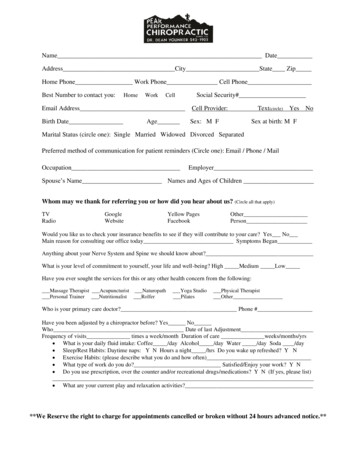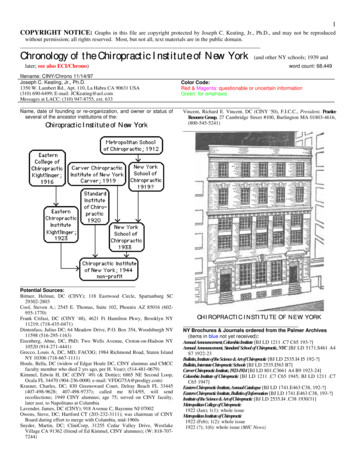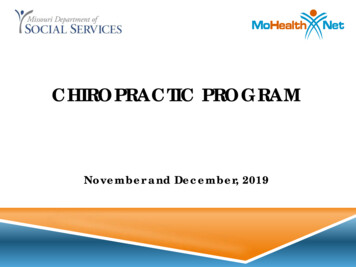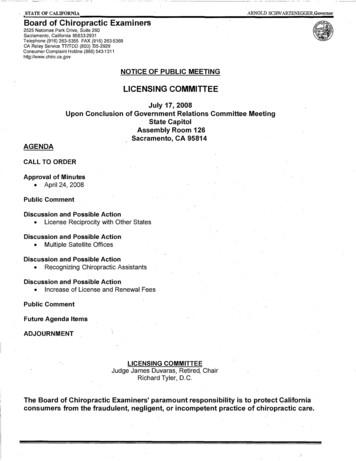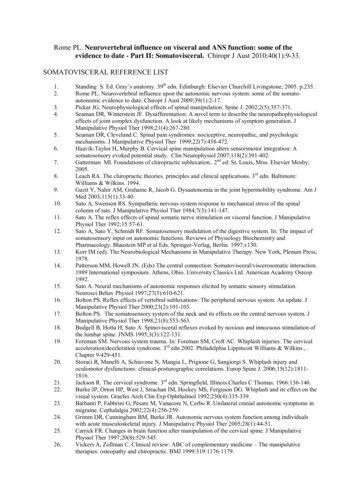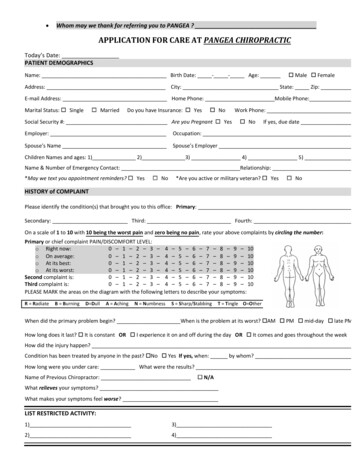
Transcription
THEFUTURE OFWELLNESSHow Chiropractic Care is Helping Improvethe Lives of Veteranswww.f4cp.orgwww.f4cp.orgThe Future of Wellness1
THE FUTURE OF WELLNESSHow Chiropractic Care is Helping Improvethe Lives of VeteransNearly 20%1 of Americans suffer from chronic pain,including 65% of Veterans.2As many of these brave former military members know, chronic pain limitsmobility, interferes with the body’s proper functioning, affects mental healthand self-esteem and has even been shown to shorten life expectancy.3Chronic pain is one of the top reasons people visit a healthcare provider,which may lead to potentially harmful, ineffective and expensive medicationsand/or surgical procedures.There is, however, a drug-free, non-invasive approach to managing pain andimproving mobility that is becoming more popular among Veterans andnon-Veterans alike: chiropractic care. Chiropractic care is a holistic healthcareprofession that focuses on conditions of the spine, muscles and nervoussystem, or “neuro-musculoskeletal” system, and also addresses the effectsthese conditions have on patients’ general health.2The Future of Wellnesswww.f4cp.org
Chiropractic care is a 125-year-old, evidence-based practice, recognized andlicensed as a healthcare profession in all 50 states, the District of Columbia,Puerto Rico, the U.S. Virgin Islands and in many other countries, includingPortugal, South Africa, Malaysia, Ireland, Canada, Mexico, Great Britain,Switzerland, Australia, Philippines and Japan.Care is delivered by a doctor of chiropractic (DC), who is a healthcareprofessional focused on the diagnosis and treatment of neuro-musculoskeletaldisorders. Like most other healthcare providers, DCs undergo extensiveeducation and training. For example, they must earn a DC degree, whichtypically takes four years, pass a National Board of Chiropractic Examiners’exam and be awarded a license in the state in which they practice.DCs focus on the spine and other joints of the body and their connectionto the nervous system to restore proper function of the body, reduce pain,increase movement and enhance wellness. Nearly half of all adults in the U.S.have seen a DC, as well as tens of thousands of Veterans.www.f4cp.orgThe Future of Wellness3
Today, the U.S. Department of Veterans Affairs (VA) continues to expandaccess to chiropractic care at VA healthcare facilities due to the increasingdemand from former military members. At the same time, more healthplans continue to expand coverage to non-Veterans for chiropractic careas more patients and providers are recognizing the dangers of opioids andother pharmaceutical painkillers and are seeking drug-free and effective painmanagement options.CHIROPRACTICCARE IS ONTHE RISE ANDIS MAKING ADIFFERENCE –ESPECIALLYWITHVETERANSWhile the number of chiropractic care patients has steadily grown over recentdecades, recent growth among Veterans has been extraordinary, likely inlarge part due to the addition of chiropractic care services in VA facilitiesin 1999.4 Between 2004 and 2015, the annual number of patients seenin VA chiropractic clinics rose from 4,052 to 37,349, an increase of 821%.Meanwhile, the annual number of chiropractic visits went up from 20,072 to159,366, which is a 693% increase.4The Future of Wellnesswww.f4cp.org
The VA and other government agencies areincreasingly recognizing how chiropracticcare is a safe, drug-free way for Veteransto manage their pain, who suffer fromthe condition at much higher ratesthan the general public.VA Secretary Robert Wilkie wrote in 2018 about his department’s “OpioidSafety Initiative,” which resulted in a 45% reduction in Veterans receivingopioids from July 2012 to June 2018.6 A part of the program is exploringdrug-free pain management methods that focus on improving functionamong Veterans, Wilkie writes, including chiropractic care, that “may reducereliance on opioids without increasing pain or causing other health problems.”Access to chiropractic care was given a further boost in 2018 with theConsolidated Appropriations Act which expanded the availability ofchiropractic services into VA hospitals. Why now? VA facilities serve morethan 5.7 million patients annually and more than half experience chronic pain– with musculoskeletal disorders (MSDs) cited as the number one source ofthe pain – specifically lower back pain (LBP).7www.f4cp.orgThe Future of Wellness5
The more studies VA and other military health officials performabout managing chronic pain in Veterans, it appears that achiropractic care path should be pursued earlier and more often.This was verified again in 2019 when the results of three clinical trials,sponsored by the U.S. Department of Defense and conducted from 2011 to2018, concluded chiropractic care improved fitness measures amongactive duty service members with LBP. The trials found that after just eightchiropractic visits over a four-week period, the active service membersreceiving chiropractic care demonstrated a 5% increase in isometricstrength, compared to a 6% decrease by the non-care control group.8Balance increased 28% in the chiropractic group, compared to no changein the control group. Endurance increased 14% in the chiropractic group,compared to a 10% decrease in the control group.“We want to keep this force going,” said Sherry McAllister, DC, president,Foundation for Chiropractic Progress. “For our Veterans’ sake, we hopechiropractic care will be available in far more than half of VA medical centersby the end of 2021. The evidence-based, collaborative andnon-pharmacological care doctors of chiropractic deliver is needed nowmore than ever.”6The Future of Wellnesswww.f4cp.org
CHIROPRACTIC CARE HAS A ROLETO PLAY IN DECREASING OPIOIDUSE AND ABUSEAs VA Secretary Wilkie wrote about in his article about his department’sOpioid Safety Initiative, the U.S. opioid crisis demands that we findcost-effective and low-risk, drug-free treatments for pain management. MSDsare the second leading cause of disability worldwide – followed by LBP –which is reported to affect 20% of adults in the U.S. and for active servicemembers and is the most commonly reported condition that interruptscombat duty.9 In addition, LBP costs the U.S. billions of dollars every yearin healthcare spending – including the additional costs resulting from lostworkplace productivity.10www.f4cp.orgThe Future of Wellness7
Since the primary therapeutic procedure used by DCs is the chiropracticadjustment (also known as spinal manipulative therapy) – DCs providea conservative, non-invasive and opioid-free treatment option for pain –particularly in Veterans with musculoskeletal conditions like LBP. Becausechiropractic adjustments are so effective, research has shown that thepercentage of Veterans receiving opioid prescriptions was lower inthose who had also received chiropractic care.11In addition, Veterans with mental health conditions such as depression,anxiety and post-traumatic stress disorder appear to have better outcomeswhen drug-free services like chiropractic care and even yoga, massage andacupuncture are integrated with other healthcare services.128The Future of Wellnesswww.f4cp.org
THE FUTURE OFHEALTHCAREDELIVERY MUSTBE INTEGRATED,COORDINATEDANDPATIENT-FOCUSED.While patients with conditions such as chronic pain are more likely to alsosuffer with depression and anxiety – these coexisting issues are particularlyprevalent in Veterans. This is why it is vital that chiropractic care is not deliveredin isolation from other services within the VA.Healthcare officials at the VA are developing such an integrated way of caringfor Veterans, which is called the Patient Aligned Care Team (PACT). A PACTincludes primary care providers, mental health professionals and DCs andmay include other clinicians such as social workers, dietitians, pharmacistsand other specialists. These PACTs work together within the VA, frequentlycommunicating and collaborating with each other to create and improve careplans for their patients that involve all three therapeutic areas.13www.f4cp.orgThe Future of Wellness9
“In the past, chiropractic has been isolated from mainstream healthcare,but today, integration is becoming more common and these PACTs area reflection of that evolution,” said Dr. Bill Morgan, president of ParkerUniversity. “The key is to integrate without being assimilated. I have done it,and I know others can do it, too. Having worked in large medical institutionssuch as Walter Reed Army Medical Center while maintaining a drug-freewellness chiropractic model, patients are hungry for drug-free, surgery-freehealthcare solutions. Doctors of chiropractic need to move from isolation tointegration, while avoiding assimilation.”HONORING SERVICE THROUGH BETTER CAREHealthcare is changing – from high-deductible health plans to telehealth andeven medical devices and wearables, the impetus is now on patients to notjust receive care, but work hand-in-hand with providers to manage their care,prioritize their own wellness and work toward their health goals.10The Future of Wellnesswww.f4cp.org
DCS HAVE AN IMPORTANT ROLE TO PLAY INTHIS NEW HEALTHCARE LANDSCAPE THATEMBRACES FINDING AND CORRECTING THEROOT CAUSE OF DISEASE RATHER THANTREATING SYMPTOMS ALONE.This has been the focus of chiropractic care throughout its 125-year historyand continues to be more widely embraced by Veterans and non-Veteransalike each year. In that time, DCs have been integral to helping patientsbuild and sustain their well-being through not only adjustments, but alsopromoting good health and prevention through education, coaching andencouraging good choices.Veterans have made the ultimate sacrifice for their country – therefore it isessential that all healthcare practitioners reward that sacrifice by helpingthem heal and feel vital and healthy once again.www.f4cp.orgThe Future of Wellness11
1. U.S. Centers for Disease Control and Prevention. “Prevalence ofChronic Pain and High-Impact Chronic Pain Among Adults —United States, 2016.” m?s cid mm6736a2 e. Accessed September 14, 2020.2. U.S. Department of Veterans Affairs. “VA research on Pain s/va factsheets/Pain.pdf. AccessedSeptember 15, 2020.3. “Severe chronic pain is associated with increased 10-year mortality. A cohortrecord linkage study.” European Journal of Pain. ejpain.2009.07.006. Accessed September 15, 2020.4. U.S. Department of Veterans Affairs: Office of Rehabilitation Services. “FactSheet for Chiropractic Services.” March 2018. tSheet.pdf5. Lisi, Anthony J. DC, and Cynthia A. Brandt, MD, MPH. “Trends in The Use andCharacteristics of Chiropractic Services in The Department of Veterans Affairs”Journal of Manipulative and Physiological Therapeutics.6. Wilkie, Robert. “Fighting Pain and Addiction for Veterans.” addiction-veterans/. AccessedSeptember 14, 2020.7. Lisi, Anthony J et al. “Chiropractic Integrated Care Pathway for Low Back Painin Veterans: Results of a Delphi Consensus Process.” Journal of manipulativeand physiological therapeutics. 122-7/fulltext8. RAND Corp., Palmer College of Chiropractic and Samueli Institute. “FinalReport to Congressional Defense Committees: Chiropractic ClinicalTrials.” gress/Signed-in-2019.September 06, 2019. Accessed: September 15, 2020.12The Future of Wellnesswww.f4cp.org
9. Goertz CM, et al. “Effect of Usual Medical Care Plus Chiropractic Care vs UsualMedical Care Alone on Pain and Disability Among US Service Members withLow Back Pain: A Comparative Effectiveness Clinical Trial.” JAMA NetworkOpen. Accessed September 15, 2020.10. Ibid.11. Lisi, Anthony J. DC, et al. “Opioid Use Among Veterans of Recent WarsReceiving Veterans Affairs Chiropractic Care.” Pain Medicine. uppl 1/S54/5089431.Accessed September 15, 2020.12. Green, B. N. et al. “Integration of Chiropractic Services in Militaryand Veteran Health Care Facilities: A Systematic Review of the Literature,”Journal of Evidence-Based Complementary & Alternative 2156587215621461?url ver Z39.88-2003&rfr id ori:rid:crossref.org&rfr dat cr pub%20%200pubmed#articleCitationDownloadContainer. Accessed September15, 2020.U.S. Department of Veterans Affairs. “Patient Care Services:Patient Aligned Care Team (PACT).” pwww.f4cp.orgThe Future of Wellness13
THEFUTURE OFWELLNESSHow Chiropractic Care is Helping Improvethe Lives of Veteranswww.f4cp.org
large part due to the addition of chiropractic care services in VA facilities in 1999.4 Between 2004 and 2015, the annual number of patients seen in VA chiropractic clinics rose from 4,052 to 37,349, an increase of 821%. Meanwhile, the annual number of chiropractic visits went up from 20,072 to 159,366, which is a 693% increase.


